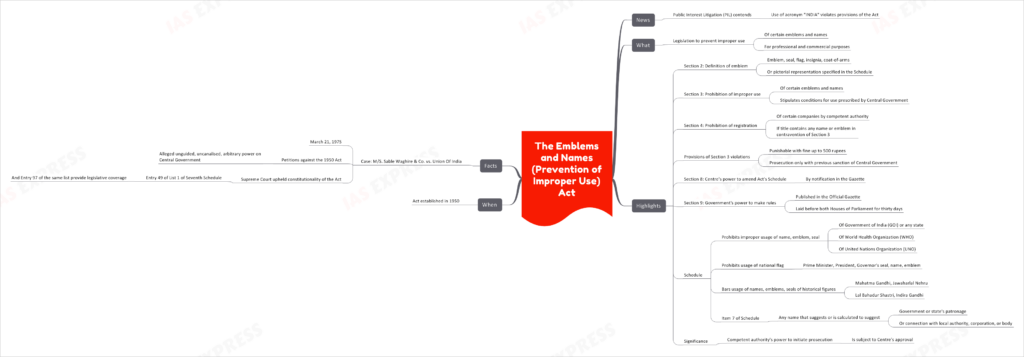The Emblems and Names (Prevention of Improper Use) Act

A recent Public Interest Litigation (PIL) has raised concerns about the use of the acronym “INDIA,” claiming it violates the provisions of The Emblems and Names (Prevention of Improper Use) Act.
This topic of “The Emblems and Names (Prevention of Improper Use) Act” is important from the perspective of the UPSC IAS Examination, which falls under General Studies Portion.
Legislation Overview
The Emblems and Names (Prevention of Improper Use) Act is designed to curb the misuse of certain emblems and names for commercial and professional purposes. It covers various symbols, including emblems, seals, flags, insignia, and coat-of-arms, specified in the Act’s Schedule.
Prohibition of Improper Use – Section 3
Section 3 of the Act prohibits the improper use of specific emblems and names. It outlines conditions for their use, which are determined and prescribed by the Central Government.
Prohibition of Registration – Section 4
Section 4 deals with the prohibition of registration of certain companies by the competent authority. If the title of a company contains any name or emblem that contravenes Section 3, it cannot be registered.
Penalties for Violations
Any violations of the provisions in Section 3 are punishable by a fine of up to 500 rupees. Prosecution for these offenses can only take place with the prior sanction of the Central Government.
Amendments and Rules
The Act empowers the Central Government to amend its Schedule by notification in the Gazette. Additionally, the government has the authority to make rules, which are published in the Official Gazette and laid before both Houses of Parliament for thirty days.
Schedule of Prohibited Symbols and Names
The Schedule of the Act includes a list of names, emblems, and seals whose improper usage is prohibited. This includes the emblems, names, and seals of the Government of India (GOI) and any state, as well as those of international organizations like the World Health Organization (WHO) and the United Nations Organization (UNO). It also bars the misuse of the national flag and names and emblems of historical figures like Mahatma Gandhi, Jawaharlal Nehru, Lal Bahadur Shastri, and Indira Gandhi. Additionally, Item 7 of the Schedule prohibits the use of any name suggesting or calculated to suggest government or state’s patronage or connection with local authorities, corporations, or bodies.
Significance and Approval
The Act grants the competent authority the power to initiate prosecution, subject to the approval of the Central Government. This mechanism ensures oversight and accountability in the enforcement of the Act’s provisions.
Upholding Constitutionality – M/S. Sable Waghire & Co. vs. Union Of India
In a landmark case on March 21, 1975, the Supreme Court upheld the constitutionality of The Emblems and Names (Prevention of Improper Use) Act. The Court ruled that the Act finds legislative coverage under Entry 49 of List 1 and Entry 97 of the Seventh Schedule.

